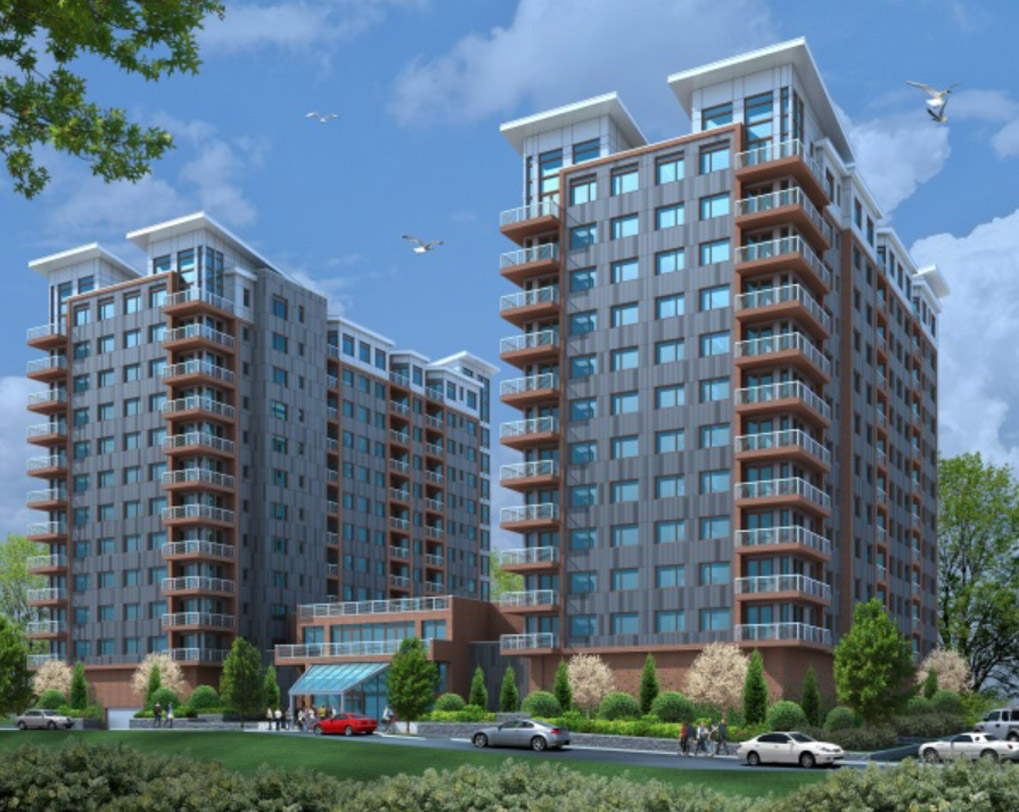The Yonkers City Council by a vote of 6-1 has decided to accept as complete a draft generic environmental impact statement for the Ludlow Street area where rezoning is planned. It”™s part of an effort to introduce transit-oriented development to that part of the city near Metro-North”™s Ludlow train station.
The action is significant for two projects that were proposed in 2017 by developer Martin Ginsburg and are featured in the draft.

One project would be at 150 Downing St. and would include 520 residential units and 10,770 square feet of ground floor retail. The units would be in towers designated as the north and south buildings. There would be a total of 62 studio apartments, 356 one-bedroom units and 102 two-bedroom units.
There would be 52 units designated as affordable. Each building would have three parking levels with a total of 529 spaces.
The second project, a 4-story building proposed for 70 Pier St. in Abe Cohen Plaza, would include 45 units and 3,600 square feet of retail space. The site is next to the Ludlow train station. There would be six studios, 18 one-bedroom units and 12 two-bedroom units. There would be 36 parking spaces.
Ginsburg Development Cos. had responded to a request for proposals issued in 2016 by Yonkers, which was looking for developer to buy the 2.26-acre Downing Street site. Before being owned by the city, Con Edison had a gas plant on the land.
“Over 40,000 residents live within southwest Yonkers and they have no waterfront access to the Hudson River,” Ginsburg officials said in the documents submitted to the city back then. “Downtown Yonkers should not be the closest point of access to the river for those who live in the southwest quadrant of the city.”
Ginsburg”™s proposal for the Downing Street site includes the creation of a promenade to provide a public green area on the east side of the Metro-North tracks with views of the Hudson and the Palisades. Additionally, the promenade would create a pedestrian connection to O”™Boyle Park to the north and the Ludlow Street and Ludlow station area to the south.
Yonkers has been putting together the Ludlow Street Transit Oriented Development Plan , which is described as a comprehensive blueprint for reviving the area. It includes zoning code amendments that would apply to parcels in the area that are on the inland side of the Metro-North tracks.
The Ludlow Street TOD Area is approximately 35 acres and almost entirely within a ¼-mile of the train station. Industrial buildings, vehicle storage lots and 4- to 5-story apartment buildings along with two- to four-family residences predominate.
While a draft generic environmental impact statement is designed to be more of a conceptual study, it can include specifics of planned developments if they are known and the one that was just accepted included details of both of Ginsburg”™s projects. The draft anticipated that Ginsburg”™s developments would have a build year of 2024. It also suggested that by the year 2030, there could be approximately 800 new apartments in the area with approximately 1,371 residents moving into it.
The draft explains that the planning goals for the Ludlow Street TOD include creating a mixed-use neighborhood around the station, maintaining opportunities for job creation, improving existing public spaces and creating new ones such as a waterfront park and improving connections for pedestrians and bicyclists.
It anticipates industrial activities in the area in addition to residential and commercial development. Among the zoning changes suggested would be allowing greater building heights next to the Ludlow Station, new setback requirements and rezoning business-restricted sections to medium density in order to allow larger apartment houses.
Although voting to accept the draft statement so that the review process can move forward, some council members expressed concerns that Ginsburg had not reached agreements with local labor unions for covering the use of union labor and wage scales during construction.
Councilman John Rubbo said, “I would urge the developer on this project to sit down with organized labor as they continue to work through this process and as we study the environmental impacts of the project in that general area. I think that everyone can come away with a very positive project, something that works for the community, something that works for the developer and something that works for labor.”
Voting against accepting the draft statement was City Council President Mike Khader who said that he did not believe it addressed issues to the level that is required.
“To be quite frank, there is a lot to be desired and is missing in the DGEIS,” Khader said. “While as many of my colleagues said this is a review process, in my humble opinion what they”™re reviewing is an incomplete or insufficient product. If done the right way this project can be beneficial for all residents in the surrounding area.”






















